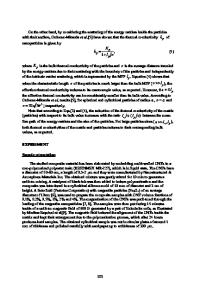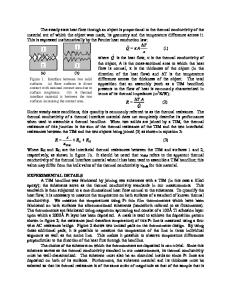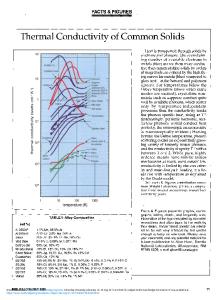Thermal Conductivity of Single-Walled Carbon Nanotube/PMMA Nanocomposites
- PDF / 258,123 Bytes
- 6 Pages / 612 x 792 pts (letter) Page_size
- 72 Downloads / 398 Views
HH3.31.1
Thermal Conductivity of Single-Walled Carbon Nanotube/PMMA Nanocomposites Csaba Guthy1, Fangming Du2, Stijn Brand1, John E. Fischer1, Karen I. Winey1, 2. 1 Materials Science and Engineering, University of Pennsylvania, Philadelphia, PA, USA. 2 Chemical and Biomolecular Engineering, University of Pennsylvania, Philadelphia, PA, USA.
ABSTRACT: Due to their exceptional thermal properties, single-wall carbon nanotubes (SWNT) are considered as very promising filler materials for improving the thermal conductivity of conventional polymers. We carefully investigated the thermal conductivity of SWNT/PMMA nanocomposites with SWNT loading in the range up to10 wt% using the comparative technique. The samples were prepared by coagulation method. We demonstrated moderate improvement in the composites' thermal conductivity of about 250% at 10wt%. The experimental results were analyzed using the versatile Nielsen model, which takes into account many important factors, like the fillers aspect ratio and maximum packing fraction. The aspect ratio of SWNT material used to prepare our composites was determined by AFM and careful image analysis in order to use it as an input parameter in the Nielsen model. We obtained good agreement between our experimental results and the predictions of the Nielsen model. Based on our analysis we concluded that higher aspect ratio of filler material was needed to achieve better improvement in the composites thermal conductivities. One should also take steps in order to improve the thermal contact between the SWNT network and the matrix material.
I. INTRODUCTION The exceptional thermal and mechanical properties of single wall carbon nanotubes (SWNT) make them a promising filler material for polymer composites. According to theoretical calculations [1] the thermal conductivity of a (10, 10) SWNT is 6000 W/mK which is higher than that of diamond. In addition, due to the very large aspect ratio of nanotubes (of the order of 2000 [2]) the percolation threshold for nanotube composites can be as low as 1% by volume. Based on this, theoretical models predict that an addition of even a low volume fraction of SWNTs would result in significant increase of a composite’s thermal conductivity. However, experimental values of thermal conductivity for polymer-SWNT composites are generally lower than those predicted by theory [2, 3, 4, 5]. Several studies [6,7] have suggested that a large interfacial thermal resistance at the nanotube-polymer interface and between the nanotubes themselves limits the thermal conductivity. An AFM study [8] has shown that the large aspect ratio of nanotubes is not preserved during the processing of nanotubes for composites. Experimental investigations of heat transport in these systems are still scarce, especially those with rigorous characterization of nanotubes incorporated into the composites. According to our analysis based on the Nielsen model, the thermal conductivity of a composite depends very strongly on the aspect ratio of SWNTs. Thus, thermal conductivity measuremen
Data Loading...











